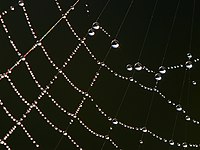
Photo from wikipedia
If thermo-plasmonic applications such as heat-assisted magnetic recording (HAMR) are to be commercially viable, it is necessary to optimize both the thermal stability and plasmonic performance of the devices involved.… Click to show full abstract
If thermo-plasmonic applications such as heat-assisted magnetic recording (HAMR) are to be commercially viable, it is necessary to optimize both the thermal stability and plasmonic performance of the devices involved. In this work, a variety of different adhesion layers were investigated for their ability to reduce dewetting of sputtered 50 nm Au films on SiO2 substrates. Traditional adhesion layer metals Ti and Cr were compared with alternative materials of Al, Ta, and W. Film dewetting was shown to increase when adhesion material diffuses through the Au layer. An adhesion layer thickness of 0.5 nm resulted in superior thermomechanical stability for all adhesion metals, with an enhancement factor of up to 200x over 5 nm thick analogues. The metals were ranked by their effectiveness in inhibiting dewetting, starting with the most effective; Ta > Ti > W > Cr > Al. Finally, the Au surface-plasmon polariton response was compared for each adhesion layer, and it was found that 0.5 nm adhesion layers produced the best response, with W being the optimal adhesion layer material for plasmonic performance.
Journal Title: ACS applied materials & interfaces
Year Published: 2020
Link to full text (if available)
Share on Social Media: Sign Up to like & get
recommendations!